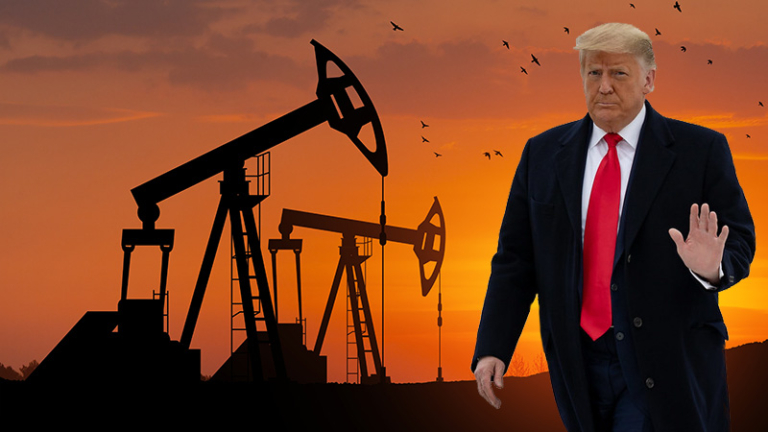
During the 2024 presidential campaign, Donald Trump made a striking promise: to cut energy prices in half within 12 months of taking office. His strategy? A dramatic increase in domestic oil production. This policy shift places U.S. energy security and affordability at the forefront, aiming to reduce the cost of living and strengthen American manufacturing.
Trump’s energy mantra—“drill, baby, drill”—has been a recurring theme since his presidency began. But is such an aggressive expansion of fossil fuel production feasible? And what does it mean for oil traders navigating the volatile global energy markets?
Trump’s Executive Orders
On his first day in office, President Trump signed six executive orders aimed at boosting fossil fuel production. These included:
- Withdrawal from the Paris Agreement – signaling a shift away from climate-focused policies.
- Lifting restrictions on oil and gas drilling in Alaska – opening vast reserves for exploration.
- Removing incentives for clean energy projects – reducing support for solar and wind power.
These moves mark a stark contrast to the previous administration’s focus on renewable energy. By prioritizing fossil fuels, Trump aims to increase domestic production, lower energy costs, and reduce reliance on foreign oil.
Declaring a National Energy Emergency
Perhaps the most dramatic executive order was Trump’s declaration of a “national energy emergency”—a first for any U.S. president. This order grants him broad executive powers to fast-track energy production and distribution, citing national security concerns.
For oil traders, this policy shift introduces new market dynamics. Increased production could lead to short-term price fluctuations, while deregulation may create investment opportunities in the fossil fuel sector.
The Alaska LNG Project: A Global Energy Play
Trump’s energy strategy extends beyond oil. His administration is actively pursuing a $44 billion liquefied natural gas (LNG) pipeline from Alaska to Japan, South Korea, and Taiwan.
- Why LNG? Natural gas is a byproduct of oil extraction. By increasing oil production, the U.S. will also see a rise in natural gas output.
- Export Strategy: LNG is cooled into liquid form for easier transport. The Alaska LNG project aims to boost U.S. exports, making American natural gas more competitive globally.
- Geopolitical Pressure: Trump has been pressuring Japan and South Korea to invest in the project, even hinting at potential tariffs if they refuse.
For traders, this project signals long-term opportunities in LNG markets, particularly in Asia.
Why Oil Prices Aren’t Falling
Despite Trump’s pro-energy policies, oil prices remain stubbornly high. Several factors contribute to this trend:
- Lingering Inflation: The Federal Reserve’s delayed response to inflation has kept interest rates volatile.
- Supply Chain Disruptions: Global energy markets are still recovering from pandemic-era shocks.
- OPEC+ Production Cuts: The cartel’s tight supply policies continue to support higher prices.
For oil traders, this means continued volatility—a challenge but also an opportunity for strategic trading.
The Tariff Factor: Impact on Energy Prices
Trump’s tariffs on Canadian and Mexican oil imports could further drive up prices. The U.S. imports:
- 4 million barrels per day from Canada.
- 450,000 barrels per day from Mexico.
Tariffs on these imports would increase refining costs, leading to higher fuel prices for American consumers. Oil traders must closely monitor trade policies, as tariffs could create price swings in crude and refined products.
The Iranian Catalyst: Geopolitical Tensions
Oil futures surged last week as U.S. sanctions on Iran led to OPEC production cuts. The administration’s intensified sanctions aim to reduce Iran’s oil exports to zero, tightening global supply and fueling price hikes.
- China’s Role: The U.S. has targeted China-based refineries sourcing Iranian crude.
- Nuclear Negotiations: Ongoing talks add uncertainty to the market.
- Supply Fears: Traders are pricing in potential shortages, driving crude prices higher.
For oil traders, geopolitical risks remain a key factor influencing market movements.
Oil Trading Outlook: Navigating Volatility
What does all this mean for traders? Despite Trump’s agenda to reduce oil prices, global factors are pushing them higher. Key trends to watch:
- Increased U.S. production – could stabilize domestic prices.
- Tariffs and sanctions – may create supply constraints.
- OPEC+ decisions – will continue to shape global oil markets.
For traders, agility is key. Monitoring policy shifts, geopolitical developments, and market trends will be crucial in navigating the evolving energy landscape.
Trade the News with GVD Markets
When trading oil, staying ahead of market-moving events is key. You need real-time analysis, expert insights, and cutting-edge tools to make informed decisions. With GVD Markets, you get everything you need to navigate global markets—from shifts in U.S. energy policy to OPEC production strategies and geopolitical developments affecting oil prices. Plus, you can benefit from award-winning trading conditions and trade CFDs on oil, forex, stocks, cryptocurrencies, indices, and more.
Start Trading with GVD Markets
